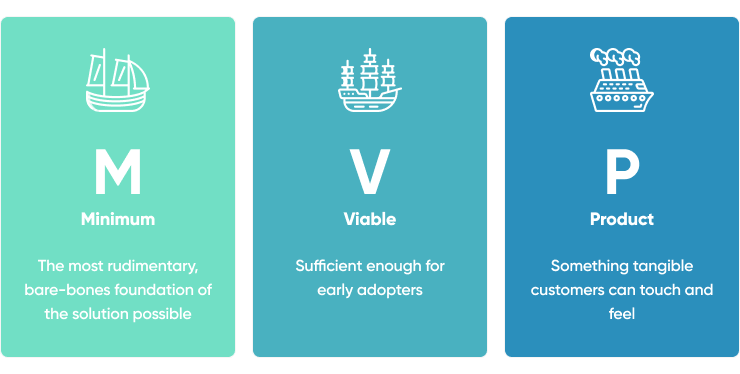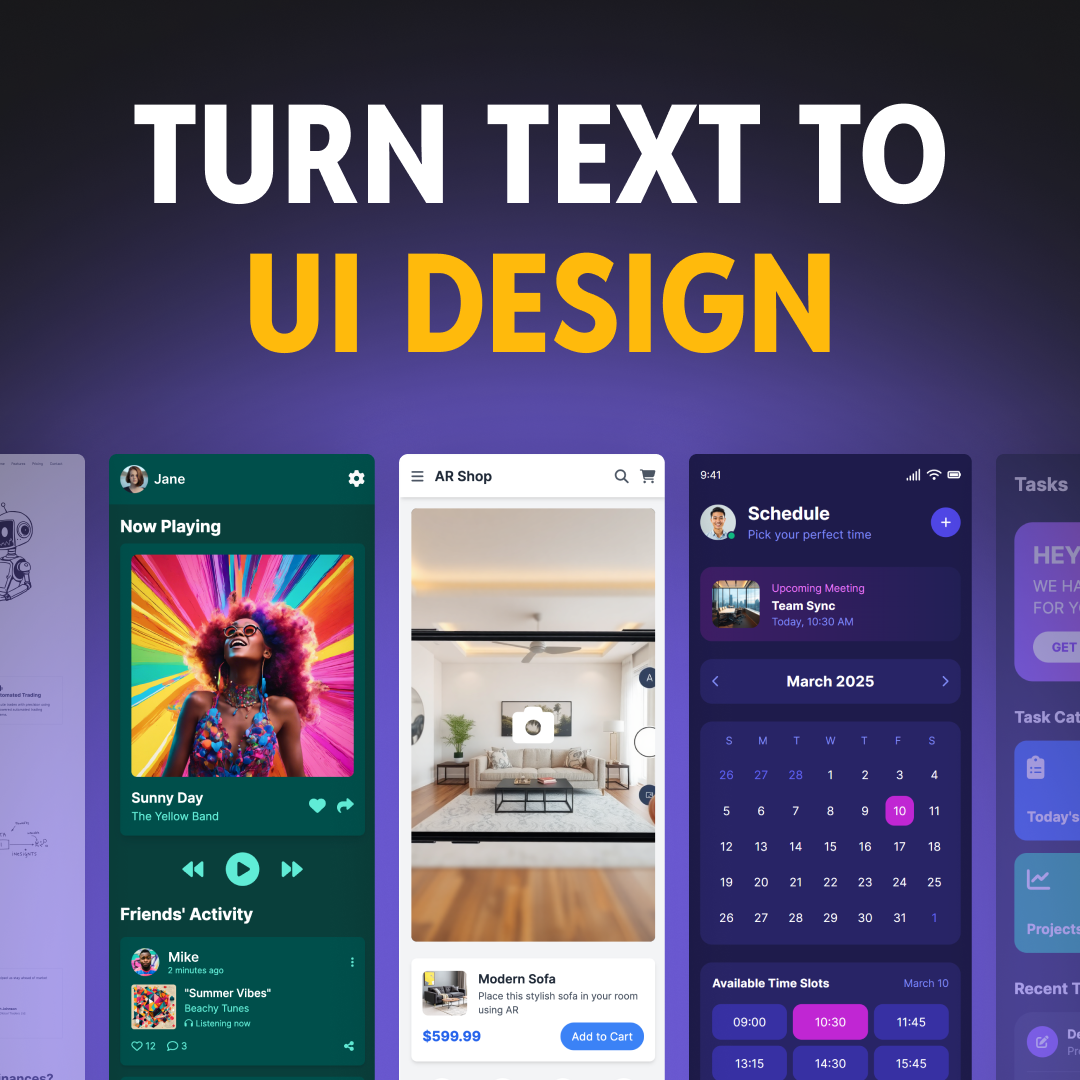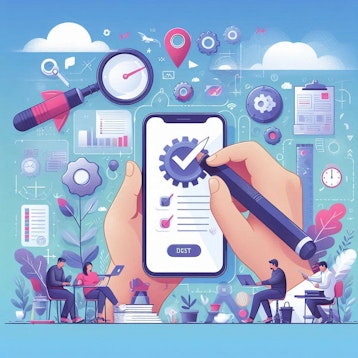The term "Minimum Viable Product," or MVP, refers to the most basic version of a product that a team can launch to start gathering feedback from users as quickly as possible. It's a fundamental concept in the startup world, particularly useful in the early stages of product development.
The idea is to create something simple that includes only the essential features needed to meet the core needs of its initial users. An MVP lets companies learn what works, and what doesn't, from their target audience.
They can use this feedback to improve. This approach helps prevent spending too much time and resources on developing features that customers might not want or need. Essentially, an MVP allows a business to validate its product idea efficiently and adapt quickly based on real user input.
Purpose of MVP
The primary purpose of creating a Minimum Viable Product (MVP) is to test and validate your product idea in the real world as efficiently as possible. This approach helps you avoid spending too much time and resources on a concept before understanding if it resonates with your target audience.
Here’s how it works: An MVP is the simplest version of your product that still allows you to gather meaningful feedback from users. It includes only the core features necessary to make the product functional and to demonstrate its value to potential customers. The goal is to launch this basic version to a select group of users—often those who are most in need of your solution and likely to provide honest feedback.
This early release is crucial because it allows you to see how people interact with your product: What do they like? What confuses them?
Do they find it valuable enough to use or pay for? This feedback is gold—it tells you if you’re on the right track, or if you need to pivot your approach. Essentially, the MVP helps you learn if your product idea is solving a real problem in a way that users appreciate.
By focusing on this iterative process of launch, learning, and adjustment, you can refine your product based on understanding user needs rather than assumptions.
This not only increases the chances that your final product will be successful but also ensures you are making informed decisions about further investments. Essentially, an MVP helps you build a product that people truly want, without burning through your budget to get there.
Importance of MVP
Building a Minimum Viable Product, or MVP, is a key step in product development. This is essential for startups entering competitive markets. An MVP has two purposes. It prevents overdevelopment and validates the problem the product aims to solve. Let’s delve deeper into each of these aspects to understand their importance.
Avoids Overdevelopment
Imagine you have an idea for a product. You spend months, maybe years, perfecting it. You add features to make it robust and comprehensive. You invest a lot of money and resources. But, at launch, you find your customers don't want many of the features you thought were essential. This scenario is far too common in the tech industry and is exactly what creating an MVP helps you avoid.
An MVP is essentially the simplest version of your product that still delivers its core value. It focuses only on essential features. Learn more about creating a successful MVP roadmap that can help you avoid unnecessary overdevelopment. This lean approach saves time, money, and effort. You won't waste resources building parts of a product that customers might not need.
Validates the problem
The second major benefit of an MVP is that it allows you to validate the actual problem your product is supposed to solve. This is crucial. Sometimes, what we see as a problem may not matter enough to customers to pay for a solution. Or, the solution may not meet the market's actual needs.
Launching an MVP gives you a clear, real-world test of your product’s fundamental hypothesis: does it solve the problem it’s intended to solve? And importantly, do people care enough about this problem to use or buy your solution? This phase of validation is critical.
It shows, firsthand, if there's real demand for your product. If so, it may suggest tweaks to better meet your market's needs.
For example, if you're making an app for restaurants to track their inventory, your MVP might include only the most basic tracking features. If restaurant managers use your product, their feedback will show whether it works or needs adjustments.
This direct feedback loop can save you from heading down a costly development path based on incorrect assumptions.
This direct feedback loop can save you from heading down a costly development path based on incorrect assumptions. In essence, an MVP is not just about developing a clear product vision; it’s about learning. It’s about understanding your customers and your market in a way that no amount of market research can achieve.
This learning guides your future decisions. It ensures any further development is on solid, validated ground. This approach boosts your chances of success. It proves your product has a market fit before you invest in its development. It’s a smarter, safer way to innovate and grow.
When to Build an MVP
When deciding to build a Minimum Viable Product (MVP), understanding the timing is crucial. It's about knowing when your idea is ready to transition from concept to a form where it can be tested and validated. Here are two essential factors to consider:
Identify Pain Points
Before diving into the creation of an MVP, you need to ensure that there is a problem worth solving. This is about identifying pain points, which are essentially the specific problems that potential users are experiencing. A pain point should be a persistent issue that affects a significant number of people. How do you know if a pain point justifies the development of an MVP? Here are a few indicators:
Frequency and Intensity of the Problem: If the issue comes up often and causes substantial frustration, it's a good sign that solving it could provide real value.
Feedback from Potential Users: Direct input from your target audience can help validate whether the problem you perceive is genuine and critical enough to warrant a solution.
Market Research: Look at what existing solutions are available and whether they are adequately addressing the problem. A gap in the current market offerings can indicate a worthwhile opportunity.
Building an MVP based on clear pain points is key. It ensures you aren't making a product. You are solving a real need. This can lead to a sustainable business model.
Existing Data Use
Leveraging existing data is a smart way to shape the development of your MVP. This data can come from various sources: market research, user feedback, online forums, and your own surveys. Here’s how you can use this data effectively:
Confirm Assumptions: Before building an MVP, use existing data. It should confirm your assumptions about your target market's needs and behaviours. This approach helps cut risks associated with product development.
Refine Your Concept: Data can reveal insights into what potential users prioritise in a solution. This understanding can help you fine-tune the features and functionalities that your MVP should focus on.
Analyse User Behaviour: Examining how potential users use current solutions can inform your design and UX. Observing what works well and what doesn’t allows you to build an MVP that improves upon existing products.
Using existing data helps in making informed decisions. It also aligns your MVP with market expectations. This increases its chances of acceptance and success.
Approaches to Building an MVP
Building a Minimum Viable Product (MVP) is a key step in product development. It lets businesses test, learn, and refine their product ideas before full-scale development. There are several ways to build an MVP, each suited to different products and resources.
To ensure a successful MVP, choosing the right tech stack is crucial, as it forms the foundation of your product's capabilities and scalability. We'll explore three popular methods: Human Automation (the "Wizard of Oz"), No Code, and Full Code. Each has unique pros and cons, and making the right choice determines your MVP's fate.
Human Automation ("Wizard of Oz")
The "Wizard of Oz" method for building an MVP is to create the illusion of a fully functional product. In reality, the operations are manually conducted behind the scenes. This method lets developers simulate a product's functionality. It avoids building the technology needed for automation.
Example: Imagine you want to start a site for custom travel plans. Instead of coding a complex algorithm to generate itineraries, you manually create them based on user inputs. To the user, the service appears fully automated, but behind the scenes, it's just you (or your team) pulling the strings.
Benefits: This approach can be incredibly cost-effective and quick to implement. It allows you to test the concept and gauge user interest without significant upfront investment in technology. To get a better understanding of this, you can explore the costs of MVP development.
Challenges: As the user base grows, keeping up manually can become unsustainable. The transition to automated solutions needs planning from the start to avoid disruptions as you scale.
No Code
No-code development platforms have revolutionised the way MVPs are built. These platforms have drag-and-drop interfaces. You can use them to build apps without coding. It makes tech creation accessible to non-technical entrepreneurs.
Tools: Platforms like Bubble, Airtable, Zapier, and Make let you build workflows, manage databases, and integrate services, all without coding. For example, Airtable is a mix of a spreadsheet and a database. It can manage content workflows or customer data.
Example: Let’s say you want to create a marketplace for freelance graphic designers. A no-code platform like Bubble lets you design the UI. You can set up a database for project details and designer profiles. You can also handle transactions. All this is possible without writing any code.
Benefits: No-code tools can significantly speed up the MVP development process and reduce costs. They also let non-technical founders quickly adjust based on user feedback, without needing a developer.
Challenges: However, while no-code platforms are powerful, they may not offer the same level of customization or scalability as custom-coded solutions. As your business grows, you could encounter limitations with these platforms.
For example, our approach in the Fintech App MVP development process showcases how customization needs might evolve, leading to a transition from no-code to custom solutions.
Full Code
The full code approach is the traditional method of building software products. This involves writing actual code to create custom solutions tailored to specific business needs. It’s ideal for products that require unique features or high levels of customization that no-code tools cannot provide.
Developer Involvement: This method needs skilled developers. They must turn business requirements into working software. It involves setting up servers, databases, and front-end interfaces. It may also require complex backend logic.
Challenges for Non-Developers: Those without a technical background face big challenges. They must choose the right tech stack, hire skilled developers, and manage the process. Non-developers must rely on technical partners or hire skilled staff. This can be costly and time-consuming.
When necessary: Use full coding if your MVP needs features beyond no-code tools. Also, use it if you expect to scale quickly and a lot. For example, a fintech startup needs custom solutions for speed and security in real-time trading. No-code platforms cannot guarantee that.
Benefits: A fully coded MVP is highly customizable and can be optimized for performance from the start. It allows for greater control over both the product features and the user experience.
Each of these approaches offers different advantages and comes with its own set of challenges. Choose based on your project needs, budget, and available tech.
MVP Readiness
Before launching a Minimum Viable Product (MVP), focus on two things: the core features and customer interaction. This focus ensures your MVP will resonate with your audience. It will also gather valuable feedback.
Core Features
At the heart of your MVP are its core features. These are not just any features. They are the essential ones that solve the main problem your product aims to fix. The idea here is to strip down your product to its most basic but functional form. It doesn't mean delivering a subpar product. It means focusing on the essential functions needed to meet users' needs.
Delivering the essential features or functionality that solves the target consumers' main issues or demands is the main goal of an MVP.
MVPs are built quickly, which makes it possible to iterate quickly and incorporate feedback from actual users to improve the product.
Cost-effective: An MVP reduces the amount of money and resources needed for development by emphasising elements that are most important.
Market Validation: MVPs are designed to evaluate a product idea's feasibility in the marketplace, assisting in the early collection of user feedback and the validation of assumptions.
Iterative enhancement: MVPs' iterative design enables ongoing user feedback-based enhancement, guaranteeing that the finished product successfully satisfies user needs.
Risk Mitigation: MVPs assist in reducing the risk by testing the product with a limited set of features.
Early Customer Acquisition: MVPs make it possible to create a user base and acquire customers early on, both of which are essential for a product's success.
Prioritise User Experience: MVPs prioritise early adopter engagement by giving a worthwhile and user-friendly experience, even with little functionality.
Because of these characteristics, MVPs are a strategic approach to product development that help startups and companies launch products fast, get user input, and iterate their way to a successful final product.
Choosing these features can feel like walking a tightrope. On one side, you want enough features to attract users and give them a taste of what your full product will offer. You risk diluting your MVP's effectiveness by adding non-crucial features.
To navigate this, focus on questions like: What is the primary function my product needs to perform? What is the minimum feature set that will solve this problem for my users? This approach creates a lean product. It must engage users and provide insights from their interactions.
Customer Interaction
After you set your core features, prepare your MVP. It's time for its first real test: interaction with customers. This stage is all about setting up the right channels and methods to collect feedback from the users who interact with your MVP. Feedback is vital for your MVP's development. It gives you key insights for refinement.
Preparing for customer interaction involves a few key actions:
Feedback Mechanisms: Implement simple and effective ways for users to provide their feedback. This could be through surveys, feedback forms, or direct channels like email or social media.
First Impressions: Ensure that the user interface is intuitive and the user experience is smooth. First impressions matter. A good experience can encourage users to keep using the product and to give feedback.
Guidance and Support: Make it easy for users to understand how to use the MVP. Provide clear instructions or a quick tutorial if needed. Also, be ready to offer support for any questions or issues that arise. Prompt support not only improves user experience but also enhances the quality of feedback you receive.
Setting the stage for effective customer interaction is crucial. It's not just about letting users try the product. It's about engaging them so they share their experiences, thoughts, and suggestions. The feedback from this phase will guide future product iterations. It will better align the product with user needs and market demands.
Timeline for Developing an MVP
Creating an MVP can take varying amounts of time. It depends on the product's complexity, available resources, and the MVP's goals. Typically, the timeline for MVP development ranges from a few weeks to a few months. This period is vital. It ensures the product meets users' initial needs. It also starts gathering feedback without delays.
Duration
The journey begins with an idea—identifying the core problem and coming up with a solution. From there, the team outlines the key features needed to address those challenges and then plans the quickest path to a working product.
A well-crafted MVP focuses on delivering core functionalities with minimal effort, allowing you to learn from real user feedback. Setting a clear timeline helps prioritise what’s essential, leaving the less critical features for future updates.
For instance, if you’re building an app, starting with a basic login and one key feature might be enough. Learn more about mastering this process in our guide, "UX MVP Mastery."
Keep it simple
A common pitfall in MVP development is overbuilding. It adds unnecessary features, layers, or complexities. This hinders the start of the user learning process. This approach delays development and weakens focus on the MVP's goals.
In contrast, understanding the differences between MVP and MLP can help you make more informed decisions about which approach suits your project best.
Overbuilding can cause major issues. It can increase costs and delay time to market. It may also fail to solve users' core problems.
To avoid overbuilding, it’s important to continuously revisit and scrutinise the feature list. Asking whether each feature is essential for the MVP or can be deferred to later stages is a good practice. This review ensures the work aligns with the MVP's goal: to validate the business concept and learn from early adopters.
Also, staying lean with the MVP helps us quickly navigate the build-measure-learn feedback loop. It lets teams adapt to real user behaviours and preferences. They can introduce changes more flexibly in response to new insights. This agility is often lost when the product becomes too bulky or complex early on.
Case Study:
Zappos
Initial Approach
When Zappos first entered the online market, its approach was anything but conventional. Instead of heavy inventory investment, the company's founder, Nick Swinmurn, chose a leaner strategy.
He began by visiting local shoe stores, taking photos of their inventory, and posting these images on a rudimentary website. When a customer ordered, Swinmurn would buy the shoes at full price from the store and then ship them. This method allowed Zappos to test the waters of online shoe sales without the need to maintain a costly inventory.
This initial strategy was the essence of a Minimum Viable Product (MVP). It was simple and stripped down to the bare essentials: a website, product images, and a way to process orders.
The goal was to test if customers would buy shoes online, not to create a perfect online store. By cutting upfront costs and complexity, Zappos quickly got valuable customer feedback. They then adjusted their business model in real time.
Outcome
The MVP approach paid off significantly for Zappos. The feedback from this minimal setup was very positive. It confirmed a strong demand for buying shoes online. Customers liked shopping for shoes from home. The many styles available made it more appealing. This validation gave Zappos the confidence to scale up its operations.
As the company grew, they gradually shifted from their MVP setup to a more traditional e-commerce model. They began to hold inventory. They expanded their product range beyond shoes to include clothing and accessories. These changes came from insights gained in the MVP phase. They let Zappos stay aligned with customer preferences and market trends.
Their MVP strategy worked, and the company grew. This caught the attention of larger market players. In 2009, Amazon acquired Zappos in a deal valued at $1.2 billion.
This acquisition wasn't just a testament to the company's financial success; it was also a validation of the MVP concept. Zappos showed that starting small, focusing on customer feedback, and scaling up is a path to success in the digital marketplace.
Zappos' MVP proved that people would buy shoes online. It also set the stage for its rise as a top e-commerce giant. This case study shows an MVP's power to test business ideas. It can minimise risk. This strategy is now a key part of the tech industry and beyond.
Spotify
Initial Approach
Spotify began as a basic technical prototype. It tested three key ideas: the public's love for streaming music, artists' willingness to join in, and the tech for instant playback. This early version was very basic. It had few features and could only play a few hard-coded songs. Despite its lack of sophistication, this prototype was pivotal in validating the concept.
By sharing this MVP with friends and family, the Spotify team quickly gathered valuable insights. They learned there was a strong demand for instant, reliable streaming. The platform could revolutionise how people accessed and enjoyed music.
This initial feedback was key in shaping Spotify's direction. It guided its evolution from a simple test model to a user-driven streaming service. It now adapts to users and technology, ensuring its success and popularity.
Conclusion
Key Takeaways
Building a Minimum Viable Product, or MVP, is an essential step for any startup. It helps you figure out if your business idea is something that customers actually need before you spend a lot of time and money on it. Using technology smartly in this process lets you create your MVP efficiently, test it out, and learn from the feedback quickly.
This approach is not just about making something that works; it's about finding out if you're working on the right thing.
An essential first step for any startup trying to verify its business idea is creating a Minimum Viable Product (MVP). The most basic iteration of your product, known as an MVP, lets you test your ideas in the market without requiring large time or financial commitments. Determining whether your business idea solves a real need or issue for customers is the aim.
Enterprising people can lower the risks involved in launching a new product by participating in the MVP process. Early in the development cycle, you can obtain important insights on user preferences and behaviours by building a basic version of your product.
It is because of this feedback that you may make necessary improvements to your product based on actual user experiences, making sure that you are not only creating anything different but also making it to target the audience.
The productivity and effectiveness of the MVP development process can be greatly increased by strategically integrating technology. Today, there are several platforms and tools available to assist companies quickly prototype their ideas, carry out user testing, and evaluate the outcomes.
For example, low-code or no-code development platforms allow business owners to build working prototypes without the need for complex coding knowledge, which can reduce costs and time.
Additionally, the MVP model encourages a constant learning and adaptability mindset. It's crucial to keep an eye on user interactions and collect continuous feedback after deploying your MVP. Finding features that customers find beneficial and those that they do not is made much easier with the help of this feedback loop.
By getting to know your consumers better, you can tailor your offering to better suit their requirements and expectations.
To sum up, the MVP approach is about confirming your business assumptions and making sure you are working on the appropriate solution, not simply about building a working product. Startups can reduce waste, make well-informed decisions, and produce goods with a better chance of succeeding in the market by using this iterative methodology.
This strategy approach is essential for businesses seeking sustainable growth since it encourages innovation and closely aligns with customer desires.
Future Considerations
Once your MVP is out there and people are using it, the real work begins. It’s crucial to keep improving your product based on the feedback you receive. This means regularly updating your MVP, fixing any issues, and maybe adding new features that users are asking for. You also need to think about how you can grow your product.
This involves planning how to scale your technology and resources as more people start using your MVP. By staying focused on what your users need and continuously adapting and expanding your product, you’ll be in a strong position to turn your MVP into a successful, fully-fledged product.
In essence, an MVP is just the beginning. It's a cycle of building, getting feedback, and making it better. Keep your users at the heart of your development process, and you're much more likely to succeed in the long run.
When considering the future use of Minimum Viable Products (MVPs), several key aspects come into play that can shape how startups and entrepreneurs approach product development and market validation. Here are some important future considerations for utilising MVPs effectively:
1. Evolving Technology Trends
As technology continues to evolve, leveraging advancements such as artificial intelligence, machine learning, and automation can enhance the MVP development process. These technologies can be used for data analysis, user experience personalization, and predictive modelling, helping startups gain deeper insights from their MVPs.
2. Data-Driven Decision Making
The importance of data analytics is growing. Startups will need to focus on collecting, analysing, and interpreting data from MVP tests rigorously. Utilising tools that provide real-time analytics can help in understanding customer behaviour and preferences, allowing for informed decisions in product development and pivoting strategies.
3. Remote User Testing and Feedback Loops
With an increasingly remote and global customer base, startups can tap into diverse markets for MVP testing. This not only enhances the feedback quality but also broadens market validation. Developing robust online feedback mechanisms will be critical for gaining quick insights and making iterative improvements.
4. Agility and Flexibility
The future landscape will likely favour agile methodologies. Startups must be prepared to quickly adapt their MVPs based on feedback. Flexibility in design and development will be essential, allowing entrepreneurs to pivot their strategies as new information emerges.
5. Focus on Customer Experience
The competition will intensify, making it crucial for MVPs to not only be functional but also provide a superior user experience. Startups should prioritise user-centric design and user experience (UX) testing to ensure that the MVP appeals to customers and meets their expectations.
6. Sustainability and Ethical Considerations
As consumers become more socially conscious, incorporating sustainability and ethical practices into product development will be increasingly important. Startups might consider how their MVPs align with sustainable development goals and ethical standards to attract a more conscientious customer base.
7. Crowdsourcing Feedback and Ideas
Utilising crowdsourcing platforms can provide a broader range of perspectives and ideas when testing an MVP. Engaging potential customers in the development process can lead to innovative improvements and foster a sense of community around the product.
8. Integration with MVP Expansion Strategies
Planning how to transition from an MVP to a full product offering will be critical. Entrepreneurs should consider future scalability and how the feedback from the MVP phase will inform incremental feature rollouts, expansion into new markets, and enhancements based on user needs.
9. Funding and Investment Readiness
Investors are increasingly interested in data-backed validation. A well-executed MVP that demonstrates clear market demand and potential for growth can be a powerful tool for attracting investment. Startups should consider how their MVP findings can support business pitches and funding applications.
10. Networking and Partnerships
Future considerations might include building strategic partnerships that can provide complementary technology or market access. Collaborating with established companies can also provide additional resources for refining and scaling the MVP.
In summary, the future of MVPs is promising, driven by technological advancements and an increasing emphasis on customer-centricity. Startups that remain adaptable, focus on data, and incorporate sustainable practices will be better positioned to leverage MVPs as a tool for innovation and validation in a competitive market.





